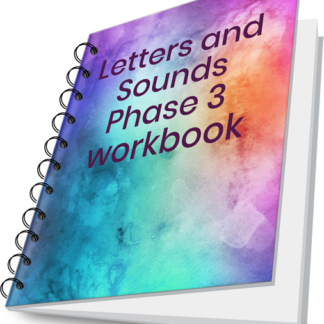Workbook 2 version 3 – teacher/clinician
$AUD30.00
This 2021 edition of the download-and-print Spelfabet Workbook 2 is for learners who know a sound for each letter of the alphabet and can write words with adjacent consonants (consonant blends). Its 100 pages of worksheets teach the consonant spellings ch, tch sh, th, ck, ng, wh and ve plus final syllable -le. It then reviews the spellings taught so far in longer words, extends words with suffixes (-ing, -es, -er, -est, -‘s; -y; -en, -less, -ly, -ment and -ness), and asks learners to complete, read then write short sentences with punctuation.
Up to 30 copies may be printed. If you want to make more copies, get the Parent/Aide version instead.
Description
This 2021 edition of the download-and-print Spelfabet Workbook 2 is for learners who know a sound for each letter of the alphabet and can write words with adjacent consonants. The first 22 of its 100 worksheet pages target the consonant spellings ch, tch sh, th, ck, ng, and wh, and when not to use ck and ng, as in ‘desk’, ‘milk’ and ‘bank’.
The book then targets the digraph ve as in ‘solve’, final syllable ‘le’ as in ‘handle’, -ing verbs, and compound words like ‘chestnuts’, ‘blacksmith’ and ‘dishcloth’. It teaches the following suffixes: plural and 3rd person -es; comparative and agent noun -er; superlative -est; possessive -‘s; adjectival -y; -en meaning ‘to make’; and the consonant suffixes -less, -ly, -ment and -ness.
It then introduces the doubling of final consonants before a vowel suffix, as in ‘run-running’, changing y to i before a suffix as in ‘happy-happier’, and contractions like ‘haven’t’ and ‘must’ve’. Finally, there are activities to build awareness of word stress and build the habit of pronouncing unstressed vowels as they are spelt when breaking words up into syllables.
The start of this book follows the same teaching sequence as the Unit 11 Sounds~Write program/books, the Dandelion Launchers and Readers Units 11-20, the last half of the Moon Dogs 2, Magic Belt and That Dog books, the first half of the Alba and Totem books and the Drop In Series Level 3 books. It then revises these and other previously-learnt patterns in longer words and sentences, and is intended to complement their workbooks, not replace them.
This workbook was designed by a Speech Pathologist to be easy for parents, aides and other non-specialists to support. The file pictures are colour, but can be printed in black-and-white if you prefer. Up to 30 copies may be printed, if you need fewer than 6 copies please get the Parent/Aide edition.
Here’s a 15 minute video which walks you through this workbook.
Here’s the contents page list of spellings and word types introduced in this workbook:
- ch as in ‘chip’, p1-2
- tch as in ‘catch’, p3-4
- sh as in ‘shop’, p5-6
- Contrasting sh and ch, p 7-8
- th as in ‘this’ (voiced) and th as in ‘think’ (voiceless), p 9-10
- ck as in ‘back’, p11-12
- lk and sk as in ‘milk’ and ‘desk, p13-14
- qu as in ‘quit’, p15-16
- ng as in ‘hang’, p17-18
- nk as in ‘pink’, p19-20
- wh as in ‘when’, p21-22
- Suffix -ing as in ‘jumping’, p23-24
- Final syllable spelt le as in ‘jungle’, p25-26
- ve as in ‘have’, p 27-28
- Compound words with three-sound syllables, as in ‘laptop’, p29-31
- Compound words with adjacent consonants, as in ‘himself’, p32-34
- More compounds with adjacent consonants, as in ‘chestnuts’, p35-37
- More compounds with adjacent consonants, as in ‘quicksand’, p38-40
- Plural suffix -es as in ‘boxes’, p41-42
- Third person -es as in ‘misses’, p43-44
- Comparative suffix -er as in longer, p45-46
- Superlative suffix -est as in longest, p47-48
- Possessive suffix –‘s as in ‘the cat’s dish’, p49-50
- Possessive suffix –‘s after words ending in s, as in ‘the dress’s frill’, p51-52
- Making plural nouns possessive as in ‘the (two) cats’ dish’, p53-54
- Adjectival suffix -y as in ‘lucky’, p55-56
- Other word-final y in two-syllable words as in ‘very’, p57-58
- Three-syllable words with word-final y as in ‘family’, p59-60
- Agent noun suffix -er as in in singer, p61-62
- Changing y to i before adding -es, as in ‘copies’, p63-64
- Changing y to i before adding -er or -est, as in ‘messier’, ‘stickiest’, p65-66
- Contractions like ‘haven’t’ and ‘that’s’, p67-68
- Doubling final consonants before a vowel suffix, as in ‘running’, p69-70
- Not doubling final consonants if there are two of them, as in ‘folding’ 71-72
- Names with contractions, as in ‘Emily’s going’, p73-74
- Derivational suffix -en meaning “make” as in ‘freshen’, p75-76
- Mixing vowel suffixes, and sometimes adding two, as in ‘sickening’, p77-78
- Consonant suffixes -less, -ly, -ment and –ness as in ‘restless’, ‘sadly’, ‘equipment’, ‘illness’, p79-80
- Two-syllable words with both syllables stressed, p81-83
- Words ending in -ic as in ‘fabric’, p84-86
- Two-syllable words with first syllable stress, as in ‘signal’, p87-89
- Two-syllable words with last syllable stress, as in ‘dismiss’, p90-92
- More two-syllable words with last syllable stress, as in ‘infect’, p93-95
- Homographs where changing stress changes meaning, as in ‘content’, p96-97
- Words with written syllables we usually don’t say e.g. ‘chocolate’, p98-100







